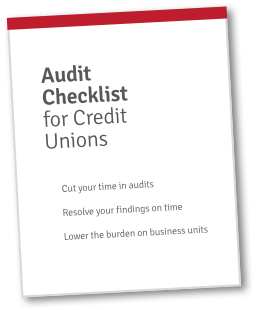Credit unions who want good audit results might consider audit automation software. But what are their options?
The way we see it, there are essentially three different options for credit union audit software. All of them can achieve great audit results.
Still, that doesn’t mean they’re all the same. Quite the contrary, in fact! Each approach is very different. Similarly, they bring with them different levels of sophistication, complexity, and efficacy.
The three different approaches are outlined below.
1. Effective Audit Software
Effective audit software is in some ways the simplest of all audit software. That’s not to say that it’s the easiest to use or the most effective, but it’s cheap, has almost no learning curve, and it works for many credit unions.
When we say effective software, we mean it satisfies minimum audit needs. Usually, effective audit software is a combination of individual audit tools tied together to make a solution.
Common examples of base-effective software include normal office productivity tools:
- Outlook
- Excel
- Sharepoint
- DropBox
Together, these tools help audit teams communicate, track, manage, and assemble necessary documents. This approach is a popular one for a couple reasons. First, it doesn’t require buying or setting up any new software—the tools are already part of the credit union’s productivity tools. Second, because the credit union already knows how to use those tools, there’s no learning curve involved.
Those benefits do come at a cost, though. There are two big issues with effective audit software. First, it takes more time to use it. Credit unions who move to more robust solutions report cutting 10–25% off their total audit completion times with audit-specific software. The second issue is that specialized audit software curtails error by automating processes.
Effective audit software is effective, but at a basic level. For more features, capabilities, and time savings, other solutions will offer better performance.
2. Enhanced Audit Tools
What we call enhanced audit tools are those that have a wide array of capabilities. Often, enhanced audit tools are designed to fit audit departments and programs of any size, and for any industry. In many cases, these tools are built with Fortune 500 and Fortune 100 companies in mind.
For enhanced audit tools, you can expect to put in a good amount of time to learn all its different uses, applications, and features. Learning, training, implementing, and managing the software can help solve niche problems specific to many industries.
Enhanced audit tools are loaded with features for almost any application. If you have the time and the money to implement a solution like this, then you can expect great results.
There are a couple downsides to these kinds of audit tools. The first one is the cost. If audits aren’t a major focus for your credit union, then effective audit tools might be a prohibitively expensive luxury. Not only that, but the expertise required to operate them is considerable—you can expect to invest a significant amount of time and resources training users and operating the system over time.
3. Engaged Audit Tools
The succinct way to describe the engaged category is this: they’re the Goldilocks solution. These audit tools are targeted toward industry-specific needs and pain points.
Whereas the enhanced audit tools work by providing dozens of features and capabilities to fit a broad range of industries, engaged audit tools provide only the features needed for one industry. Engaged audit tools offer essentially the same performance as their enhanced siblings.
The limited functions ensure a much easier learning curve. Plus, they focus on the goals that credit unions specifically look to accomplish, and they do those things very well. The results from using audit software from the engaged category are faster, more efficient audits with less risk of error. Some of this comes from features like automated audit trail creation, reminders, and submittal. Some of it comes from the intuitive communication, collection, and management features.
The downsides to this category are that they do cost more than the "effective" tools. However, if you’re saving time on your audit, then it might be a worthwhile investment.

FREE: Audit Checklist for Credit Unions
4 key principles and 9 questions to jumpstart your audit planning. From leading credit unions.Conclusions About Audit Automation Software
Credit union audit software can be the key to improving already-sound audit programs. Especially when an audit team is clicking at 100%, they’re being held back by their tools. To remove any technological bottlenecks, audit automation software can help your team accomplish more in less time than before.
If you’d like to learn more about credit union audit automation software, subscribe to our blog or click the links below. Or, if you’re preparing for an audit now, check out our credit union audit checklist here.
Do Credit Unions Need External Audit Tools?
Two Important Factors that Impact the Value of Audit Software for Credit Unions





